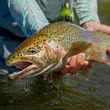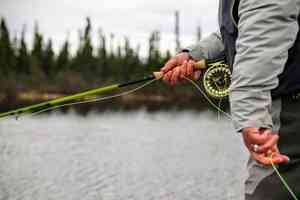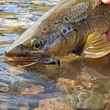It wasn't that long ago that relatively little was known about how and where bonefish spawn. It was 2013 when scientists discovered that these flats-dwelling fish, who spend the vast majority of their lives in shallow water, actually spawned in water as deep as 164 feet. And it was just last year that researchers from Florida University and Bonefish & Tarpon Trust (BTT) published a study demonstrating that not only did bonefish spawn in deep water, they did so in water as deep as 450 feet, after gathering near shore in schools as large as 5,000 to 10,000 fish and migrating distances of up to 70 miles.
According to BTT, starting in autumn and ending in early spring, bonefish gather near shore in large numbers, where they prepare to spawn by porpoising at the surface and gulping air to fill their swim bladders. At night, they swim offshore and dive hundreds of feet before quickly reverse directing and bolting back towards the surface. This causes a rapid change in pressure which makes their swim bladders expand, causing them to release their eggs and sperm. Fertilized eggs develop into hatched larvae which then drift in the ocean’s currents for roughly two months before settling in shallow bays where they develop into juvenile bonefish.
Those near shore, mass gatherings just prior to heading en masse to the depths to spawn, or pre-spawning aggregations (PSAs), as they are formally called, are considered a crucially important stage of the bonefish spawn and identifying locations where they happen is critical to bonefish conservation, researchers say. Asked why identifying PSAs is so important, Dr. Aaron Adams, BTT's Director of Science and Conservation, told Hatch Magazine that "bonefish migrate from a large geographic area to reach the PSA, thus damage to these sites can cause direct impacts to the adult population that uses the PSA. These PSAs are also the source of larvae that provide new recruits to both local and distant populations. Negative impacts to PSAs, such as due to habitat loss or degradation or disruption of spawning behavior by boat activity, decrease spawning success, which reduces the contribution to the next generation. Harvest of Nassau grouper from spawning sites in the Caribbean, for example, has caused population crashes."
Previous studies have revealed the location of PSA sites in places like the Bahamas, Belize, and Cuba, but spawning sites in the sensitive bonefish waters of the Florida Keys have remained a mystery.

“There are a couple possible reasons that might explain the lack of known spawning sites in the Keys,” said Dr. Ross Boucek, Bonefish & Tarpon Trust’s Florida Keys Initiative Manager. “Maybe for a time the size of the spawning school in the Keys shrank to the point that it wasn’t noticeable to us. Or maybe the size of the Keys population became so small that the fish completely stopped spawning for a period of time. Fish won’t spawn if there aren’t a critical number of spawning fish.”
Until now, that is. According to Bonefish & Tarpon Trust, by using acoustic telemetry and drones, they are honing in on likely PSA sites they believe bonefish guides first identified decades ago.
Much of this latest discovery revolves around a single bonefish, otherwise known as "fish #8599." During the project, the 24-inch long female was tagged by Dr. Boucek, roughly 20 miles east of Key West. Three months later, fish #8599 was detected using acoustic telemetry more than 45 miles away, moving through the backcountry, and was then subsequently detected in 100 foot-deep water along the Florida Keys Reef Tract. According to BTT, given that bonefish typically have a two to three mile home range and that fish #8599 was detected in deep water near the full moon in December, she was likely on her way offshore to spawn.

“Capturing a part of 8599's migration gets us closer to finding Keys bonefish PSA locations, which is essential for conservation,” said Dr. Boucek.































Comments
capt chuck brodzki replied on Permalink
thanks for the bonefish article. unfortunately, it is incomplete and potentially flawed. i personally know for a fact (witnessed and fished it twice over a week) that there is (was) a spawning site (PSA) in the upper keys near the power plant flat in south biscayne bay (circa 1990). in fact, i was accompanied by 2 giants in the fishing industry on each of the 2 separate occasions who are veritable witnesses. my memory of the event is clear and incontrovertible since i recall and gleefully visualize that i caught one of the big dogs on a 5 wt flyrod (8 lb tippet) for a MB Rod & Reel Club award for my efforts. furthermore, i heard about this special place and special event thru a fishing legend who supposedly knew and fished the event for many years and could serve as the "expert witness".
Pages